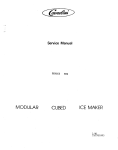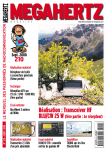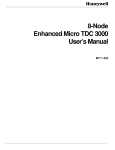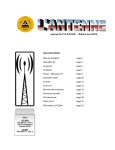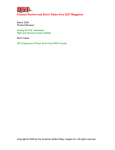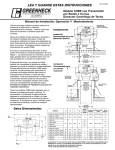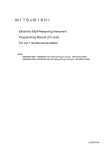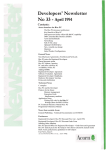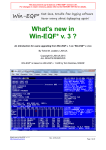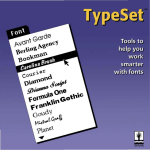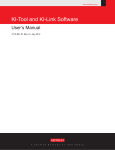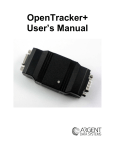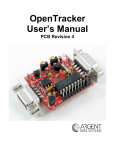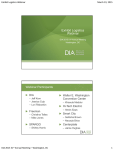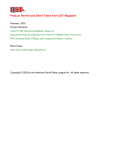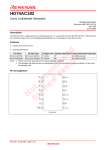Download Radio Amateur - On Line Ham Radio Class
Transcript
Radio Amateur News & Views The Official Journal of the Radio Amateurs of Northern Vermont MARCH 2002 BEHIND THE SCENES – BROADBAND INTERNET AND CABLE The March 12th RANV Meeting Thinking of upgrading to Broadband Cable Internet service? Or, if you have Broadband Cable, ever wondered how it works (or why it doesn’t work sometimes)? Or, have you ever questioned how all those hundreds of TV channels come out of the little box on top of the TV? Or even wondered why you hear a big fat carrier on 145.25 MHz all over town? Well, you’ve come to the right place! Our March meeting will feature Mike KB1FUV speaking about all of the above and more. Mike works for Adelphia Communications and is involved with a lot of the behind-the-scenes stuff to make all the cable programming work. He will be able to explain the setup and answer a lot of your questions. But, don’t bring the fruit for throwing if you have lackluster service! We want Mike back for a second talk on Repeater Linking Next Month! All of this craziness takes place on Tuesday, March 12th. Dinner and premeeting warm-up start at 6 PM at Zack’s on Williston Road. The meeting starts at 7 PM at the O’Brien Civic Center, 113 Patchen Road, South Burlington. Hope to see you all there. Don’t forget your RANV Jackets! Vol. 12 No. 3 COMING UP! The last 5 weeks have been wild and woolly, with the Vermont QSO Party, a pair of DX and 160 Meter Contests, and, of course, the Milton Hamfest. Things will quiet down briefly and then the activities will come bang-bang again! March 16th is the Weekend Ham Radio Class. There is still time for some latecomers to jump in and get their ham licenses. Our next meeting, April 9th, is on Internet Repeater Linking Project (IRLP). This is a fascinating system where repeaters all over the world can be linked up. After, we will be working to provide this function. Our first Fox Hunt of the year will be Friday, April 19th. W1SJ will once again be out there to drive you nuts. Also on that Weekend hams will helping out with the Vermont Public TV Travel Auction. And that brings us to May 3-4th – Hosstraders! And Spring! RANV JACKETS You've seen them at the hamfest and agreed, "Wow, they are sharp looking". We are talking, of course, about the new RANV Jackets. You didn't place an order at first, but now you want one. Here are the details. The jackets from WearGuard of Norwell, MA. The particular jacket that we have ordered is Style: 414, Color: Bl. They sew three things on to this jacket: 1. RANV Logo (#756412) on front left, 2. your callsign in gold on right, 3. Radio Amateurs of Northern Vermont in light blue on back (optional). The base jacket costs $50. The embroidery can run $10-40 additional, depending on if we get the half-price discount and if the back is embroidered. To this, also add shipping costs. We got a good end-of-year sale the first time. Those who hesitated will have to pay a bit more more this time. Debbie is willing to put together another order. If we have several jackets together, we will get savings on the embroidery and shipping. Contact her directly at [email protected]. IN THIS ISSUE... Milton Hamfest 2002 Contest Corner ARRL Field Org More DX Clusters Welcome to RANV FYBO Results HF Activities HF Techniques OUR LAST RANV MEETING by Charlie W1CHG, Sec'y The meeting was called to order by the President Paul AA1SU at 7:13. After introductions all the way around, it was announced that the first of the RANV jackets have arrived after many miscues by the vendor. These look very sharp with very distinctive logos. Dave W1DKL will provide the March meeting refreshments. It was announced that the May meeting will be a barbecue at Brian and Sara’s (N1BQ/W1SLR) QTH. Brian’s place is totally solar powered, so that should be the technical discussion of the evening. The Field Day site is in much better shape than as reported before. Field Day is June 22-23rd – mark it on your calendar. Mitch appealed to all members to promote and attend the Milton Hamfest. He was also looking for volunteers to help with tables and setup on Friday night before the hamfest and volunteers to staff the club tables during the hamfest. Mitch appeared to have enough volunteers to fill the posts. The speaker for the evening was Mike N1JEZ. The topic of the night was “Beyond Line of Sight Communications.” He first spoke the methods behind Meteor Scatter Communications and how the new WSJT software automatically encodes and decodes information for much more efficient meteor scatter communications. We all got to see the program in action and heard just what WSJT sounded like. The talk shifted to the JT-43 mode of communications where weak signals can be copied by computer right out of the noise. Mike told us that with JT-43, one could communicate several hundred miles and with WSJT, out to around 1500 miles. Not bad for VHF and UHF! After the enlightening talk, the group broke for some soda and cookies. Later a vote was taken and passed to spend $50-100 for a set of BADGES? THE PREZ SEZ by Paul AA1SU, President We have a batch of badges for people who have joined RANV over the last year, and at Milton. RANV gives all new members a light blue callsign badge. We have also extended this service for folks who change their callsign and need a new badge. Lately, there have been an increasing number of people requesting a badge to replace one which was: 1. put in the wash; 2. run over by a streamroller; 3. eaten by the dog; etc. Please take care of your badge! At some point, we will have to draw the line on replacing badges for whatever reason. They do cost money to make and our provider has raised the price dramatically. I will notify people I have new badges for by E-mail. Please make an extra effort to come to the March meeting. This saves us from having to mail them, which is a slow and tricky process. Contacting RANV In Person: Meeting, March 12, 7pm, O'Brien Civic Center 113 Patchen Rd, So. Burlington By Mail: PO Box 9392, So. Burlington, VT 05403 By Radio: 145.15 repeater WW Web: http://www.ranv.org President Paul AA1SU [email protected] VP/Tres: Brian N1BQ [email protected] Secretary: Charlie W1CHG [email protected] Editor: Mitch W1SJ [email protected] 860-1134 899-4527 434-5995 879-6589 Please send submissions for the newsletter to the editor, W1SJ. amateur radio books for the Underhill/Jericho library. The meeting was adjourned at 9:00. 2 The Milton Hamfest has come and gone, and boy, what a success it was! We had an marked improvement in turnout, eight forums, two exam sessions, and tons of eyeball QSOs. Members have remarked to me how much fun it was just to hang around in groups and talk to people. You should know by now that this is one of the key elements that make a hamfest successful. The camaraderie is a very important part of the whole hamfest experience. Plus, I saw a lot of bargains going out the door, as Debbie and I were collecting the admission money. Thanks to all of you that came out and made this such a nice event. I hope that you all had fun. We have a jam-packed year planned out for you folks. The meetings are just going to get more and more interesting. The charity events that we cover this year are going to train more new hams to be ready for unusual circumstances. The fox hunts will be under way soon. Field Day will be here before you know it, and new hams will be getting on the air, getting a taste of HF, and well as VHF on SSB. All this, and the year will only be half over. You gotta love this club, eh? So, by all means, please stay in touch with the club any way that you can. We all have busy lives, and we can only do so much. I encourage those of you who have not been able to be radio active, to do so this year. There is just an enormous amount of modes and bands to explore in this hobby. Surely, there must be something that interests the inactive ham. Why, did you know that at the April meeting, we will be discussing a way to chat on repeaters around the country from the comfort of your home computer? It is just amazing some of the things that we have covered, and what we will be covering in the months to come. So, hang on tight, and I’ll see you on March 12th. MILTON HAMFEST 2002 by Mitch W1SJ T remendous! That was the word I heard describing the 20th annual Milton Hamfest. Over the last few years, it has been very hard planning the hamfest program. The question I often ask, “how do we top last year’s great show?” The answer always comes down to using sound hamfest planning principles: give ‘em more of what they want and they will come! It’s not always clear what “they” want, but that’s the fun of it. The 2002 hamfest hit 550 attendees. This topped the last two years, in which we were in the 450-475 range. This year’s attendance was about the same as the attendance in 1997-99. This is a very good sign! Perhaps it is a trend that hamfests all over will start getting better this year. Or, hamfests could continue their slide and we are the odd case. In either scenario, we come out fine. For the first time, the number of vendors was down. Usually we have about 90 tables (6-foot) of vendors. This year it hit around 70. A number of factors contributed to this. First, we lost Radio Bookstore this year, as Craig had a family situation to tend to. Thanks go to Rhyne at Radio Devices, who took up the slack in the book sales area. He did a great job, because few people really noticed. A few other of the big connector vendors also didn’t make it up this year, perhaps due to the soft economy. A new trend has developed in that vendors flock to the back flea market room. Years ago, vendors considered it an exile area. How things change! This caused an abundance of tables in the front room. I certainly didn’t want to run out of tables at 8:00 like what happened last year. Go figure. The drop in vendors didn’t seem to bother many. Paul and Debbie, at the vantage point at the door, saw hundreds of pounds of junk make their way out to the parking area! New this to Milton was full service QSL Card checking. While Fred (VUCC) and I (DXCC) had no takers, Linda W1MP was busy for a long time checking WAS QSL cards. Paul AA1SU also found someone to check his WAC QSL Cards – rumor has it the janitor checked them! The VE Sessions had increased traffic this year. There were 26 applicants who picked up 18 upgrades or new licenses. Some of the people upgrading: W1DKL, N1HLP, N1NZH to Extra and W1DEB, KB1EZC, KB1EZD, KB1EZE to General. There was major activity at the RANV table this year. How do I know this? We picked up 6 new members (a record), a number of renewals, sold out of the RANV T-shirts and even sold out of the Vermont Amateur Radio Directories. This is a first! Fred commented to me that stuff was flying off that table at an amazing rate! The forums were spectacular. Of course, I would say that, since I organized them. But those aren’t my words, they are yours! At 8:30, the QRP Forum packed the room, filling all 35 chairs and then some. That set the tone of the day with full forums and people buzzing around outside discussing all the wonderful tekkie stuff they just learned. The sad part is that it all happened so fast in those 3 hours. Before you knew it, the show was done! I am particularly happy about how the forums program has grown over the years. It has been our goal to make Milton more than just a flea market filled with boat anchors. This year, more than any other, we proved that Milton is a full service Convention. Planning the hamfest is quite easy. I made a list of the things that need to be done before the show and it is surprisingly short. However, if you leave anything out, you’re dead! One of the key activities, and one of 3 the hardest, is obtaining local publicity. It entails going after the print, radio and electronic media and convincing them that the Milton Hamfest is an important community event. Simply sending them a fax doesn’t work – faxes often go ignored. I managed to get a piece in the Free Press on the Thursday before the show, which helped greatly. Also on Thursday, I chatted with Mark Johnson on WKDR 1390 and WDEV 550 about the Milton Hamfest and amateur radio. Each week, my engineering work requires I interrupt Mark’s show to run an Emergency Alert System test (EAS, or the old EBS). This time, I got to interrupt myself! Hey, it’s a form of packet radio, why not? Reaching out to the community is vital to keep the hamfest and amateur radio growing. It’s a pain sometimes, but we must all do it. Help is always needed to publicize the hamfest and amateur radio. Milton has come a long way from 20 years ago when 3 people ran it. So, here is the list of folks who make it happen. Please take the time to thank them when you get a chance. Setup: Paul AA1SU, Ted K1HD, Howie K2MME, Ron KK1L, Fran KM1Z, Brian N1BQ, Don N1QKH, Eric N1SRC, Fred N1ZUK, Mitch W1SJ, John WA1RMS Tickets: Bob KB1FRW, Paul AA1SU, Debbie W1DEB RANV Table: Charly W1CHG, Fred N1ZUK, Grant K1KD, Brian N1BQ, Don N1QKH Forums: Brian N1BQ, John VE2EQL, Mike N1JEZ Henry KT1J, Ron KK1L, Mike W1RC, Bob WE1U, Jim N1NK. Rick N1RL, Tom K1KI Examiners: Jim AA1BO, Ted K1HD, Tom K1KBL, Joe K2KBT, Fran KM1Z, Brian N1BQ, Ed N1PEA, Eric N1SRC, Fred N1ZUK, John NV1Z, Mitch W1SJ CONTEST CORNER ARRL FIELD ORGANIZATION by Paul AA1SU Official Observer & Official Emergency Station The results of a few recent contests have been published in the March issue of QST. In the 2001 IARU HF World Championship held last July 1415th, Jim N1BCL managed to rack up 234 QSOs and 41 multipliers for a total of 30,217 points in the single operator category. Way to go Jim! In the September 2001 VHF QSO Party, once again our own Mitch W1SJ operating as WB1GQR used his operating skills and fine Mt. Equinox location to rank number two in the country for Single Operator-Low Power. And once again, he did this using only four of eight available bands. Mitch reports that these were “The best conditions in a lifetime!” In the QSO and Multiplier Leaders boxes, he led on all four of the bands that he worked, which were: 50 MHz, 144 MHz, 222 MHz, & 432 MHz. Nice going Mitch! In the nosebleed category of contests, Mike N1JEZ worked the 2001 ARRL 10 GHz Cumulative Contest last August and September. He made the top ten box for numbers of different call signs worked on 10 GHz only, at 34. That may seem like a low number, but this is a tough two-weekend contest. Moving on to the upcoming contests, the Russian DX Contest is Saturday, March 16th starting at 7 AM and lasting for 24 hours. Exchange is RS(T) and serial number. This is a good way to work on your Worked All Oblasts Award. Rules are on page 102 of the March QST. There is also the Alaska, Virginia, and Montana QSO Parties on the air for you to hand out valuable Vermont contacts for. March 29th is the CQ WW SSB WPX Contest. This is a 48 hour contest that will help get you ready for Field Day, as well as add to your DXCC totals for the year. The exchange is signal report and serial number. This is the contest where your call sign prefix is the multiplier. Examples are W1, K1, KC1, N1, KE1, KK1, and the very rare AA1 for us, and HC8, P40, SP3, EA9, TA3, S59, PY4, JA1, UU0, etc for the DX stations. Stateside contacts count for points too. Contest software is highly recommended. Of course, not all contests are mentioned here. This is just to motivate you a little. Other sources are QST, CQ Magazine, and National Contest Journal. Another source on the web is www.arrl.org/ contests and www.hornucopia.com/contestcal. Next month: The premier of The New England QSO Party. by Paul AA1SU In an ongoing series of articles to make Vermont amateurs more aware of how they can help serve the ham radio community, we present two more ARRL Field Organization job descriptions. The minimum requirement for any appointment is that you be a full member of the ARRL. Applications for appointments can be found at www.arrl.org/fandes/field/org. Do you want to know one way in which hams assist each other with diagnosing transmitting irregularities? The League has sponsored the Official Observer (OO) Program for more than fifty years. The OO is the backbone of the Amateur Auxiliary to the FCC, and performs his or her function by listening rather than transmitting. While tuning around the band, the OO keeps an ear out for such things as frequency instability, harmonics, hum, key clicks, broad signals, distorted audio, over deviation, out of band operation, etc. Once an operating or technical irregularity is detected, the OO sends a card to the offending station. A response from the other station is not required; the OO's job is done. The requirements are a little more intense than the appointments we covered already. The OO must take and pass a test, must have been a Technician Class or higher license for at least four years, must report to the OO Coordinator (OOC) on a regular basis, and must maintain regular activity in sending out advisory notices as needed. In hard-core rules violation cases, OOs refer problems to higher ups in the Amateur Auxiliary. Currently there are a few Official Observers in Vermont, but there may be room for more in your neighborhood. During times of emergency, hams are often called to duty. However, there must be amateur radio operators around the state that set the high standards of emergency preparedness and operating procedures that we reply upon for guidance. The Section Manager (SM), as well as some other section level appointees can appoint amateur operators as an Official Emergency Station (OES). The OES must be familiar with ARES and must make a deeper commitment to the program in terms of functionality, than does the rank-and-file ARES registrant. The appointee carries out specific functions and assignments designated by the Emergency Coordinator (EC). The major areas of responsibility are Operations, Administration, Liaison, Logistics, Management Assistant, and Consulting. The OES appointee may be assigned to pre-disaster, post-disaster, and recovery functions. He or she is also expected to do a variety of other functions that we don’t have room for here. For a more complete appointment description look on the link mentioned above. Current OES's include Les W1UT in Charlotte, and Micky K1XH in Wilder. So why not consider one of these appointments for yourself? You may have been wondering how you can get more involved with ham radio in Vermont. This may be your ticket. 4 MORE DX CLUSTERS Welcome To RANV by Fred N1ZUK This month, I had promised you a more in depth look at using filtering on the DX cluster, to help you find the information that’s of interest to you. Instead, I will push that back to next month, and instead we’ll talk about what’s new at DXBVT, and pass along some useful information. First off, there now is a web site up and running to support the DXBVT DX Cluster. Along with a very well written user’s manual by the author of the software, and Ian G0VGS, there is information on the cluster, and how to get the most out of it. There’s also useful links, and photos of the operation. The site is http://n1zuk.home.dyndns.org. Next, I’ve had several people tell me that they have been having problems accessing the cluster via Telnet. I’ve been trying to work one on one with each of them to resolve their issues. The trouble is mainly due to the terminal program on their computer. Unfortunately, the folks who write software these days keep adding more features to their programs, having them do more than what the Telnet standard was written to do. This causes the terminal program on your computer to hang, waiting for a response that it never gets from the cluster software. So, what’s the solution? Well, several things could be done. I could try and accommodate every one of the hundreds of different terminal programs out there, but I’d need to quit my job to devote enough time to do this (If anyone wants to support me at my current lifestyle, I may be willing to do this). Another option is to see if you can configure your program to behave closer to the written standard. Try going in to your program’s options (may also be called preferences or configuration), and making sure you’ve set it for a VT100/VT101 terminal, and have the local echo turned off. This will resolve the problem on a number of terminal programs. Probably the best solution is to use one of the programs that have been tested to work correctly with the DX Cluster. On the support web site, there are links to many terminal programs that work fine with DXBVT. I’ve also included links to several logging programs that integrate the DX Cluster terminal within the logging program. Combined with a radio that has CAT (a computer interface), this is a powerful way to work a lot of new DX. These programs connect to the DX Cluster, and as the spots come in, compare the station to those you have in your log. You can set up the logging program to sound an alarm if the station is a new DXCC, on a new band or mode, etc. You can then just click on the station, and the radio will tune to the frequency, ready for you to work them. Of course, if your radio doesn’t have computer control, you can always tune it manually. During the recent ARRL DX SSB contest, this was done quite successfully at the KK1L multi-op effort. Connected through the radio port for the full 48 hours of the contest, KK1L benefited by the over 25000 spots that came from the 1000+ users connected to the network (that’s about one every 7 seconds!). By clicking on the unworked stations that were listed in the logging program, many stations could be worked in a short period of time. Remember, not all contests allow packet spotting, and many that do require you to enter as an Assisted class. Make sure you read the rules before the contest, and follow them. On a side note, I noticed many of the operators at KK1L came from the ranks of RANV and W1PU (Road Kill ARC). W1PU also has a new web site, at http://w1pu.home.dyndns.org. That’s it for this month. Next time, I’ll help you sift through the wealth of information available on the DX cluster. Wow, we have a big list to give you: Mike KB1FUV of Essex, attended the Weekend Class last year and will be speaking on Internet Access and IRLP at upcoming RANV meetings. Philip WB7EKM of Addison, has been a Novice for many years, and upgraded to General at the Weekend Class last fall. Ron KB1HRV of Burlington, is active on many of the area repeaters. Fred WA1LIE and Jo KB1EPT of Waitsfield are active in both RANV and CVARC Steve KA1JUN of Georgia, attended the very first class taught by W1SJ (then WB2JSJ) in 1982! His son will be at class next week – 20 years later! Matt KA1KLJ of Burlington, attended the second class taught by W1SJ in 1983. He was little, then! Steve N1HLP of Fletcher has been licensed over 10 years and just picked up his Extra at Milton. Stuart WB2PBH of Williston has also been licensed for many years. Carolyn N1SKM of West Boylston, MA, is president of the Central Massachusetts Amateur Radio Club in Worcester and is active in DX. Her son is Robert KB1EVV of East Burke. John VE2EQL of Greenfield Park, PQ has been a Forum Speaker at Milton for the last two years and is an avid QRP enthusiast, taking part in the FYBO contest at N1BQ’s QTH. Ham Steak? Oh noooo! 5 FYBO RESULTS HF ACTIVITIES By Brian N1BQ By Mitch W1SJ The Northern Vermont QRP Society is group of local operators, many who are RANV members, who get together to operate a few of the larger QRP (low power) operating events each year. Again, this year we operated in the annual Winter Field Day known as FYBO (Freezing Your Butt Off) sponsored by the Arizona S-QRP-ions Club. We set up in Field Day style – no fixed station equipment, just hastily erected antennas and battery power. The location was in the yard at N1BQ’s QTH. The temperature ranged from +5°F to +24°F in the bright sun (about 18°F actual) back down to about +5°F at shutdown (9PM). One of FYBO’s major quirks is a score multiplier that goes up as the actual temperature at the operator’s position goes down. As with last year’s operation we easily qualified for the maximum multiplier of 6X. We operated single rig multi-op, switching between a pair of Elecraft K1's on 40-20-15, and a Ten-Tec on 10. We ran dipoles to fiberglass poles jammed into the snowbanks and tuned them with the built-in antenna tuning unit on the K1’s. Power came from Gel Cells, which were charged by a 60-watt solar panel. The sun was so bright that we only connected the solar panel for about 10 minutes each hour to keep the battery up. Operators were Bob WE1U, Fran KM1Z, Brian N1BQ, John VE2EQL, Eric N1SRC, and Sara W1SLR. Also present in body or spirit were Kristin AA1SK, who wasn’t feeling well but made a pot of killer chili, Ralph KD1R, and Suzanne, John’s wife, plus an interested aboutto-be ham and his father. We had 87 contacts, with 32 SPCs, and took multipliers for Field operation (x4), Alternative Power (x2), and well under 20°F temperature (x6) for a total of 133,632, just up from last year’s 133,056. On the culinary front, we started the morning with fresh bagels from Burlington Bagel Bakery compliments of Fran, and fresh croissants from Montreal from John. Lunch was baked baby back ribs marinated in Bob’s special sauce for the last two days; dinner was a fabulous beef stew and some fresh Montreal French bread from Suzanne and John. Kristin’s killer chili was an all day affair (literally and figuratively!). Sara added fresh baked chocolate chip cookies. We may have been colder than heck out there operating but there was always something to look forward to! Look for pictures at http://www.wulfden.org/NVQS. There has been lots of HF activity in our area over the last month. Ron KK1L put together an excellent operation in the ARRL DX Contest this past weekend. The category was two-transmitters. The main station used tribanders stacked at 60 and 90 feet, while the second used a Vertical. Nine operators pumped out close to 2500 contacts for a score of over 3 million. The highlight was that none of the amplifiers broke down. Last year, two amplifiers went up in smoke, so this was a definite concern. The operating team consisted of AA1SU, K1HD, K1KD, K1WEY, KC1WH, KK1L, N1ZUK, W1DEC and W1SJ. The score put us in the middle of the pack, which is not bad, considering that the operating approach was half competitive and half fun and the station was off for a few hours overnight. Two weeks earlier, KK1L was on for the CW portion of the ARRL DX Contest with a smaller multiop contingent of K1KD, KK1L, KM1Z, W1CX and W1SJ, who produced a score of around 1 million. I ran a few hours of CW DX at close to 100 per hour and it was a real slap in the face; but fun! Thanks to Ron for opening up his station and allowing us all to have fun and to wife Laurie for putting up with all the strange guys in the basement! There was some activity in the CQ Worldwide 160-Meter contests as K1KD and I played a little in the CW portion. In the phone portion, which was Milton Hamfest eve, I got on for a mere 46 minutes and had a big pileup. But with a 5:45 wakeup call for the fest, the fun ended early! The surprise participant in this contest showed up Saturday evening as W1DEB, exercising her new General privileges, banged out 57 QSOs on the top band. You can track what RANV members are up to in the latest contests by checking the web, http://www.ranv.org/scores.html. REPEATER OPERATING As you may know, we have a noise problem on the 145.15 repeater. To tie us over until this problem can be fixed, a second receiver was installed in Chittenden County. To use it, simply turn OFF your CTCSS tone. If you go back over the mountains to Central Vermont, turn ON the tone. This should be simple enough. Hardly a week goes by without someone bellyaching about the noise. And when I check, I find that BOTH stations are running tone (using the mountain receiver) and are well within range of the local receiver. This upsets me greatly. We go to great lengths to make the system work. All you need to do is to use your equipment properly. After reading this, get out the manual for whatever radio or radios you use and learn how to change tones and offsets – while driving. If that is when you use the radio, then know how to safely change things or program it . We are trained amateur radio operators who ought to be experts on this. There is no excuse. During last year’s Marathon, two operators kept transmitting on the output of the repeater, causing confusion for everyone They weren’t aware or didn’t know how to set the offset. Learn! One day, someone’s life may depend on your ability to use your radio properly. That is not the time to be messing with the manual! 6 IMPROVE YOUR HF OPERATING by Mitch W1SJ M ore and more amateurs are upgrading and focusing their efforts on the HF frequencies. HF communications using SSB requires stricter adherence to operating procedures. Unlike the full quieting, high fidelity signals of an FM repeater channel, HF is filled with wide ranging signal levels, very tight filtering and a good deal of interference from transmissions on either side of one’s frequency. In my activities as a contester, I complete on the order of 8000 QSO’s each year, a routine which has occurred for over 25 years. At the receiving end of the pileups, it is quite obvious which operating techniques work and which ones don’t. This article will be the first of several on techniques to make you a better HF operator. PUT ON THE HEADPHONES It never ceases to amaze me how many times hams do not or will not use headphones. A classic example is a scene from the video, “The New World of Amateur Radio,” where several operators are straining to copy signals on multiple receivers at a Convention, of all places! It’s so ridiculous, it is funny. Unless you are engaged in a casual contact, where signals are truly “armchair copy” (as we like to say), use headphones. You will be surprised how much more you will hear! Years ago, I was surprised when I heard a tape of myself operating and noted how many calls I missed. A switch to the proper headphones after that dramatically improved my copying ability. Headphones come in three general types: lightweight “Walkman” types, single-ear types and full muffs. I almost always use the lightweight phones in quiet locations such as in the shack, while using the full muffs in noisy locations, such as at a public service event. Some like the single-ear types when they have to listen to both radio and live people. This is a personal decision, as I personally don’t hear very well with these. I also find that headphones really help out in HF operating while mobile, but be sure to use lightweight phones which allow you to hear horns and sirens and be careful to not use these where they are prohibited. LEARN TO SAY YOUR CALLSIGN It is also amazing how many hams do not know how to properly send their callsign. You would think this is a no-brainer. When trying to dig a weak W3 out of the noise on 10 meters, how the operator presents his or her callsign will most likely determine if the contact is possible. First, always use proper phonetics. If you are not going to give your callsign phonetically, then don’t bother giving it at all. Why? Because it will likely be copied incorrectly. In a contest, points are deducted for miscopied information. Frankly, I am not willing to waste time on anyone who will not send their callsign correctly. Make sure you use one of the standard phonetic alphabets. Don’t make up your own phonetics, as this will confuse the issue. The ARRL and ITU each recommend a particular set of phonetics, but there are phonetics used by used by police and the military. DX operators also use alternate phonetics as some words are hard for them to pronounce. If the receiving station cannot copy a part of your callsign, try using a different phonetic word. That is usually all it takes. Some words and syllables have very low energy content and are hard to hear in noisy conditions. Knowing when and how to switch phonetics is an important tool. If the station you are calling does not get your callsign, keep screaming your callsign (and I mean just that!) and try different phonetics. If you are persistent and really, really want to get though, you probably will. However, if you casually “mention” your callsign a couple of times, you’re likely to not get though. How bad do you want it? The FCC gave you a callsign which is 4-6 characters long. They did not authorize a shortcut of two letters. Never (and I mean NEVER) use two or three letters in place of your call. Trust me when I say that hams who do this really shoot themselves in the foot. There are all sorts of folklore propagated by poor operators who claim that this really helps. Bunk! When numerous stations are calling, my goal is to collect the most number of characters of one person’s callsign so that I have a unique station to go back to. I want to make 7 sure that only ONE station replies – not 2, 3 or 30. When you give the entire callsign, I have a prefix, a number and a suffix to grab from you. There is a far better chance to get more of your callsign this way, then by just giving two letters, which may very likely by shared by someone else. And even if there is no pileup, giving two letters causes me to have to ask for a repeat of your callsign since I only have two letters at the start. If you feel your callsign is too long, whip out a check to the FCC and get a short call, but whatever you use, use the whole thing. When saying your callsign, say it once or twice, and that’s it! Unless there is QRM on frequency, don’t say my callsign. I already know what it is, and I also don’t need to hear it to peak my attention. I can’t tell you how many operators will give my callsign, and then say their callsign quickly, without phonetics. So when you hear a station calling CQ or QRZ?, wait for them to stop transmitting, pause a second, and give your callsign once, with phonetics. Say your callsign with gusto, with the idea that your life depends on the station returning to you. Attitude most certainly counts! In a pileup or under poor conditions, you might give your callsign a second time – but stop there. Don’t call until you establish that the calling station is listening for you only. Further calling will cause QRM to someone else’s exchange, causing that contact to take longer and causing you to wait longer! Never append anything onto or after your callsign! Saying your QTH or “QRP” or “mobile” might make you feel important but it really fouls up the process. I can’t tell you how many times I’ve put variants of W1QRP in the log! Don’t say it – it is not going to make anyone hear you any better. If you have to say anything, say your callsign. Sometimes, shouting “Vermont!” during a pileup has helped me get through, but this is done with discretion and only after my call is clearly enunciated with phonetics. Now, your homework for this week is to practice saying your callsign phonetically into a tape recorder. And buy headphones! See you next time. NEXT MEETING: “Behind the Scenes of Broadband Internet and Cable” Tuesday, March 12th, 7PM O’Brien Civic Center RANV http://www.RANV.org P.O. Box 9392 South Burlington, Vt 05407 8








